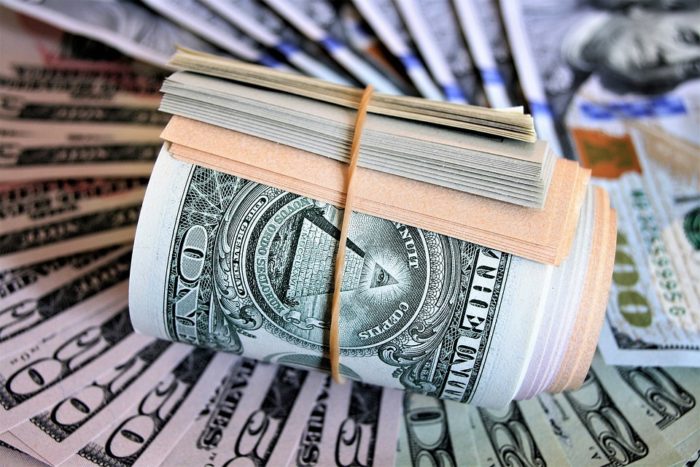US Economic Forecast Part 2
US Economic Forecast Part 2
China’s manufacturing sector has been declining, particularly of late. The communist led country is suffering the worst economic forecast of the last 50 years. China’s in more trouble than anyone will admit even if they print more money to alleviate the losses.
China’s propaganda mills are trying to wash over the tremendous harm the Wuhan virus has inflicted on the world (300,000 deaths) and trying to stop countries from bringing goods sourcing to domestic markets. That’s needed because China supply chains have become unreliable. While the world was left in the dark about the danger of the virus, China stockpiled its own supplies in advance.
Now many countries lack medical supplies to help them deal with the outbreak. Some countries still have no face masks and are heading back to their workplaces. There is a big disconnect for many nations such as the US, Canada, Australia, France and the UK. China’s trade surpluses will shrink dramatically as countries deal with their new debt loads.
While the media are glossing over this rejection of China, the fact is the US cannot continue importing China products. The import era is over, and it coincides with President Trump’s commitment to America First. The Democrats focus on sustaining China’s cheap labor supply chains won’t sit well in the upcoming election.
With so many unemployed, and Fed funds drained, the only solution is to raise protective tariffs to build production in the US.
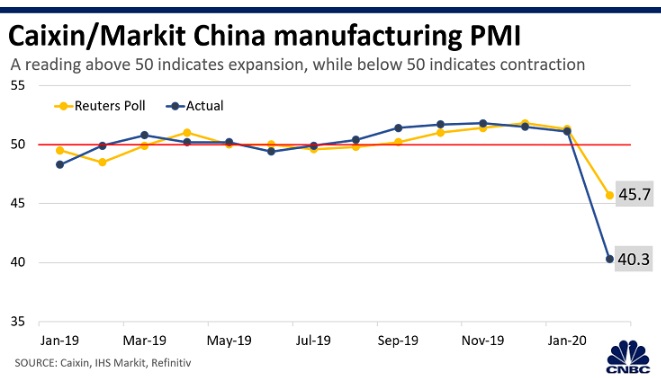
With virtually no government growth, the private goods and private services sectors have risen to compensate.

As you can see, the difference between U.S. residents’ foreign financial assets and liabilities, was a deficit of $10.95 trillion at the end of the third quarter of 2019. And goods and services trade has taken a turn for the worse.
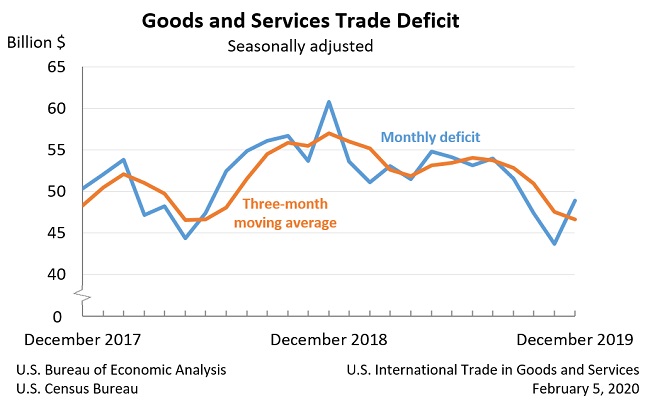
Investment in US companies

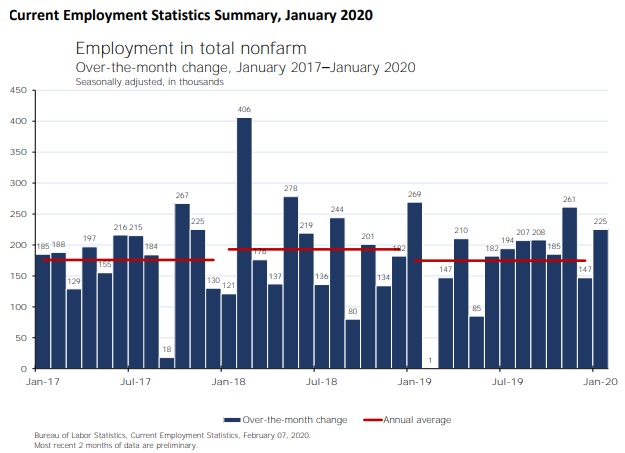
Job Creation in US. Chart courtesy of BEA.gov
2021 Economic Forecast
We look to US economists, unbiased, and ask where the key factors are headed. Of course, they only focus on specific factors that may not be reflective of real economic trends. They all seem to be in agreement that GDP will fall and perhaps unemployment will rise.
Of all the factors listed above, we might focus on interest rates. With rates declining, there is less pressure on consumers and US businesses. If President Trump uses quantitative easing to lower the dollar and build demand, US manufacturers should be able to continue getting established and producing.
They’re still in the nest so to speak, not ready to compete full head on with an establish Chinese export machine that enjoys low currency rates, low wages, and unfair trade deals. The President is slowly dismantling China’s tactical advantage, and it’s another sign the US economic forecast might be brighter than most believe.
The conference Board forecasts that US economic growth will decline to 2.0% in 2020 from 2.3% in 2019. The Fed believes GDP will slow to 1.8. This is one time when the politicians wish they’d made sure the poor are housed and have more money. The Fed believes unemployment will rise to 3.7% in 2020.
Business capital expenditures look to be declining and this may be the most worrisome trend. However, with China shut down and the rest of the world in recession, investment money is entering the US because this country looks to be the strongest on the globe.
Recent Economic Updates
- economy grew 2% in 3rd quarter
- wages rose .6% in August
- 136,000 jobs added
- consumer spending grew .1% in August
- income growth outpaced spending so savings grew
- total us personal income rose $73 Billion
- disposable personal income rose $77.7 Billion
- personal consumption rose $20 Billion
- the PCE index rose .1% in August
Data above from the Bureau of Economic Analysis
Enjoy further market forecasts, political angles, stats and charts, and expert insights right here on this blog. What we can say is that in 2020, the correlation between the stock market and the economy is weak. And minimal connection between the housing market and the economy. Fast growth and change bring strange events.
Please Do Share This on Facebook and in your blogs!
Is China Hurting?
China’s economic forecast may be worsening, but its balance of trade is very strong thanks to the US. Its trading partners are running huge deficits.
China is reeling in the reality of 5% GDP growth when it has planned for 8%. They fully expect the US and other countries to support China’s supply chains. However, now with the virus scare, companies around the world are reassessing their dependence on China. They had forgotten the economic, political, military, cultural and health risks they’ve been allowing for over 2 decades now. The trade deficit with China is stubborn, with wealthy American consumers continuing to buy overpriced Chinese exports. This is a big problem for the President.
However, the long term outlook looks a lot brighter now.
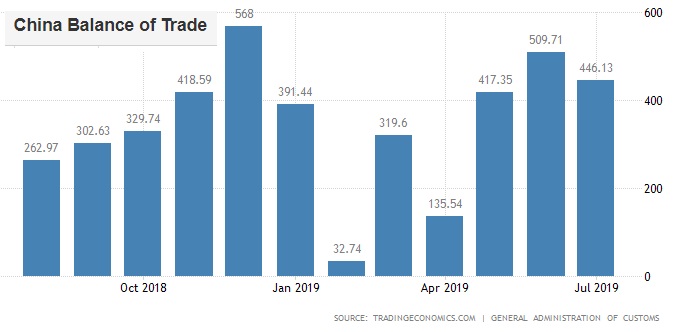
The America First transition looks to be wobbling its way forward as the President paves the way for US companies to grow, and place barriers for unfair foreign manufacturers. US manufacturing and jobs creation however have slowed with the trade turmoil. Both China and Mexico have expressed reluctance to continue trying to wear down President Trump.
What are the key issues to watch:
- China’s rapidly receding economy and plunging exports
- Bernie Sanders and a socialist regime threatening to damage free enterprise
- US tax revenues helping to ease government debt problems
- import tariffs beginning to force corporations to buy from US suppliers
- will corporations build their manufacturing operations in the US in 2019?
- US dollar stays strong making US exports tougher to maintain
- US manufacturing numbers keep declining?
- stock markets pushing to new record highs
- too much volatility will cause business to pull back spending
- anti-trust charges being laid on big monopolies?
- interest rates continue to decline?
- oil prices staying under control?
- inflation is weak, perhaps non existent
- housing prices stay relatively flat meaning more affordability
- what will President Trump’s next actions be?
The best news is the Fed’s expectation of interest rate cuts which the stock markets loved this week. Democrat’s claims of big inflation and crashed retail sales have not materialized. The economy keeps rolling forward, making the 2020 election predictions favor the President.
China Says They Don’t Want a Trade War
Chinese leaders suggest in formal statements that they want to trade. President Trump has initiated a 3 phase trade deal that would create $60 billion in agricultural exports. Good for US farmers but not something that will delight US manufacturers and tech companies.
A good guess is that this trade deal will fall apart. With China in recession, it can’t afford to buy from the US. Chinese leaders have resistance so ingrained, they will likely not meet the agreement. Experts say China has never lived up to agreements.
How It Looked in the First Quarter
US stock market performance was excellent in 1st quarter. Major economists reporting very positive results.
“As small businesses across the country make up 99.7% of all U.S. employers and 64% of net new private-sector jobs, they truly are the backbone of the country’s economy and an aggregate indicator of its health and status” — from Fundera Report on the Booming Economy.
Latent demand for goods in the US remains high, and when tariffs and US manufacturing grows, Americans will buy more US made products.
Fantastic Outlook for US Business and the Housing Market
The lagging housing market and small business sector should regain their stride once multinationals are forced to build factories in the US (Jan 1st, the 25% import tariff took effect. No free access for China is expected). The coming 10% tax break for the middle class makes 2019 look very good.
Multinational corporate stock market performance (NASDAQ, DOW, S&P and TSX) may see some further corrections as imports from cheap labor pools into the US dwindle. Here is NAR’s latest economic outlook:
According to the St Louis Fed, forecast factors are as follows:
- 30-year fixed mortgage rates (extended downward rate trend despite the recent upward push by the Fed which they have ceased)
- Existing home sales (suffering a lul, but with recovering economic performance will see sales stimulated again)
- Real house prices (house prices have flattened, and construction has risen)
- Contribution of residential investment to GDP growth (the contribution of residential construction is rising, however investors and builders might not like the recent economic numbers)
Despite the short term volatility and negative stock market predictions, the US economy will grow. With inflation reported this month at 2.4%, there is little reason for the Fed chairman to raise interest rates.
Good Times Ahead for American Producers
What this report translates to for 2020 and beyond, is stronger employment security, prime market access for US companies, better housing, more opportunities for young people with big student loans, returning entrepreneurial spirit, higher wages, and hope for a poverty/housing that has been plagued for many years.
Manufacturing in America: Welcome Home
Consumers are not fulfilled and production capacity will grow. The talk of embargos on US goods are overstated for sure. Resentment from Europe, Japan, Canada, and Mexico will subside. US manufacturing output will grow in quality and the world will want US products. Who wouldn’t want reciprocal access to the US market?
American consumers are expecting good things. They’ll buy any house they can get their hands on and they won’t be buying as many Toyotas, Mercedes Benz and Beemers as before. Fords, Chevys and Tesla’s will be in good demand.
Trading economics forecasted 93.1 consumer confidence rating for fall 2018. It’s actually at 100.8 despite all the political and trade volatility.
The End of Free Trade
The end of Free Trade was predictable. American poverty, debt, and misery and lack of control has brought it to a stop. Fair Trade will be the new norm.
The defense of globalization rests on viewing Americans primarily as consumers, not workers, based on the assumption that we care more about low prices than about low wages — NY Times article
Free Trade wreaked havoc on American lifestyle, wealth, politics, and optimism. It was a concept for the 80’s, but it’s not the 80’s anymore. It has ruined people’s lives. The stock markets continue their happy upward direction.
A US housing crash is unlikely and the stock market looks pretty healthy. However, a global recession would affect the US as would a China collapse. President Trump knows it, which is why he keeps pulling back on 100% commitment to many of the policies he sets forth.
Housing starts keep growing as depicted below, and with demographics so positive (Millennials and Gen Z’s coming soon), the demand will be steep. It’s a fantastic time to be in US real estate.
America’s Burgeoning New Self-Esteem
It’s this matter of self-esteem of the American people that’s so critical. CNN and other media paparazzi think esteem is something dished out in scathing news reports. But what’s happening is a nation’s self-esteem is being regained and this time inoculated against media manipulation (the Media and big advertisers don’t like that).
How Could Anyone Vote Against This US Economic Boom?
The US renaissance has generated massive employment and improvement in lifestyles. And while the rich have benefitted most, as usual, the game isn’t over. With more investors making the transition to US equities, we see a reduction in hysteria over predictions and forecasts.
“Overall the report is good news insofar as it suggests the economy still has some capacity to grow at an above-trend pace without generating much inflationary pressure,” said Michael Feroli, an economist at JPMorgan in New York — Reuters report
In the meantime, the latest jobs report reveals continuous, excellent 200k+ job growth each month and droves of people coming back into the workforce. Skill shortages are a true threat to US manufacturing revitalization. People will have to be trained. The education industry should enjoy their outlook.
The unemployment rate rose to 4.0 percent in June from an 18-year low of 3.8 percent in May as 601,000 job seekers entered the labor force in a sign of confidence in the labor market — Reuters report.
Employed persons rose to highest levels in history.
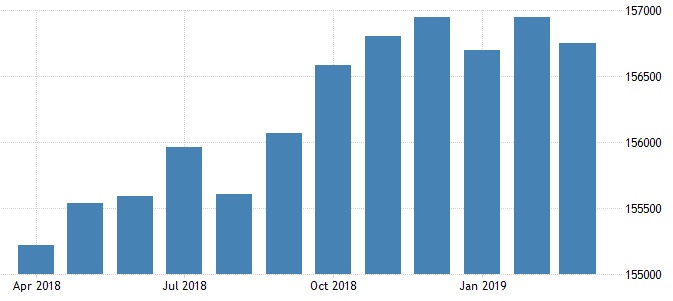
The housing market could be better, yet construction is okay and demand is certainly strong.
This chart above shows the growth of the US housing market will likely pick up its pace in the last half of 2019. Interest rates are expected to stay low, putting little pressure on defaults, and keeping demand for new construction nice and healthy. Homebuyer are sitting on the fence hoping for lower prices, however a housing market crash is very unlikely.
This kind of growth is more resilient, aware of danger, ready for events, so it’s in control. It would take something massive to stop its forward thrust.
What’s the last word in the US economic revival? Momentum. It’s gone through its temporary adjustment period in the winter of 2019 and there’s lots of forward drive into 2020. The US economy is robust and growing and few will want to see this fantastic, business life-giving economic cycle end. As stock markets modernize and adjust, we’ll see the DOW Nasdaq and S&P all improve in 2020.
Return to Part 1 of the Economic Forecast
3 to 6 month Forecast | Stock Market Today | 10 Year Stock Market Forecast | Real Estate Market 2023 | 5 Year Stock Forecast | Dow Jones Forecast 2023 | NASDAQ 2023 Forecast | Florida Real Estate |Boston Real Estate | Los Angeles Real Estate | Forecast for Housing Market | Housing Market News

